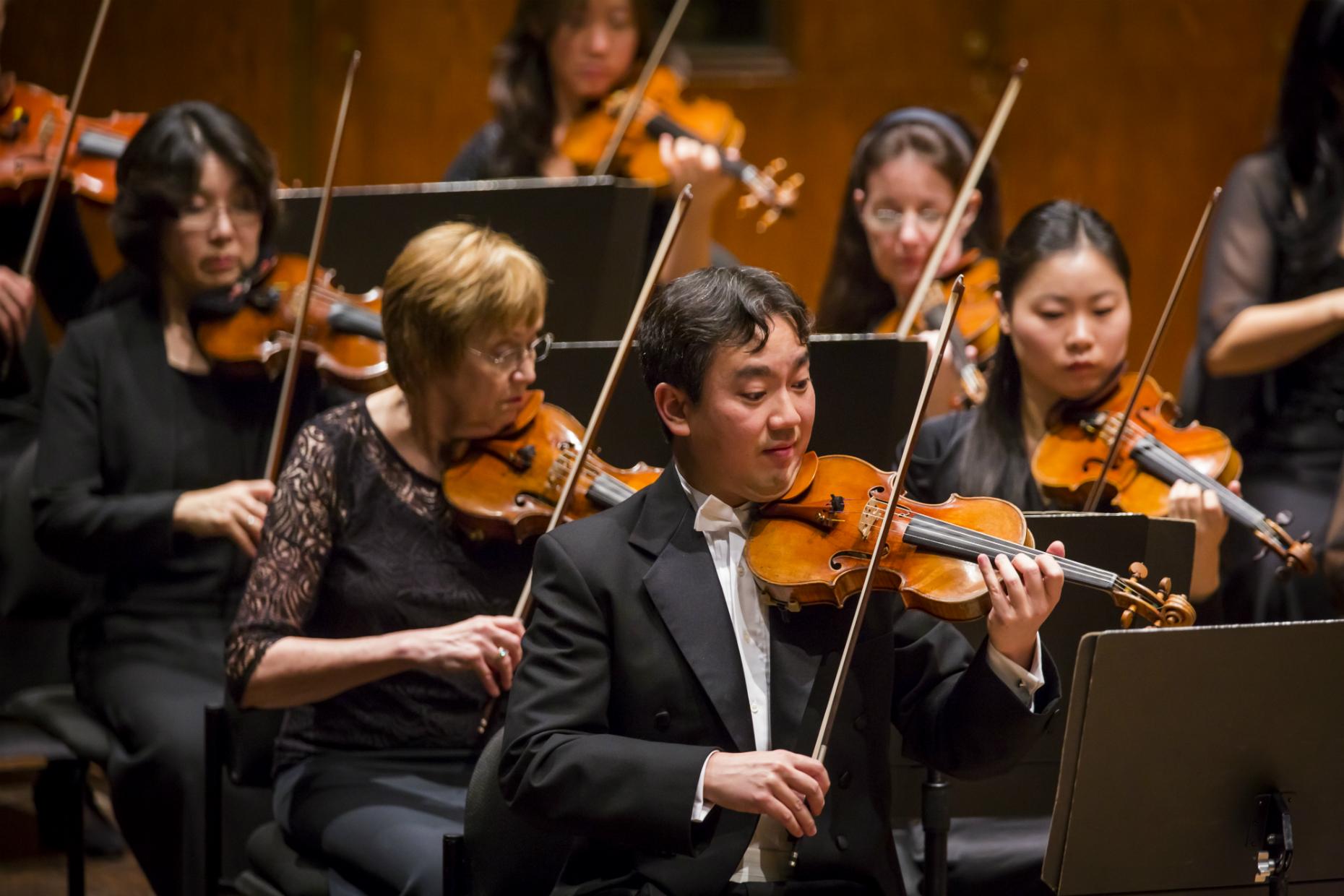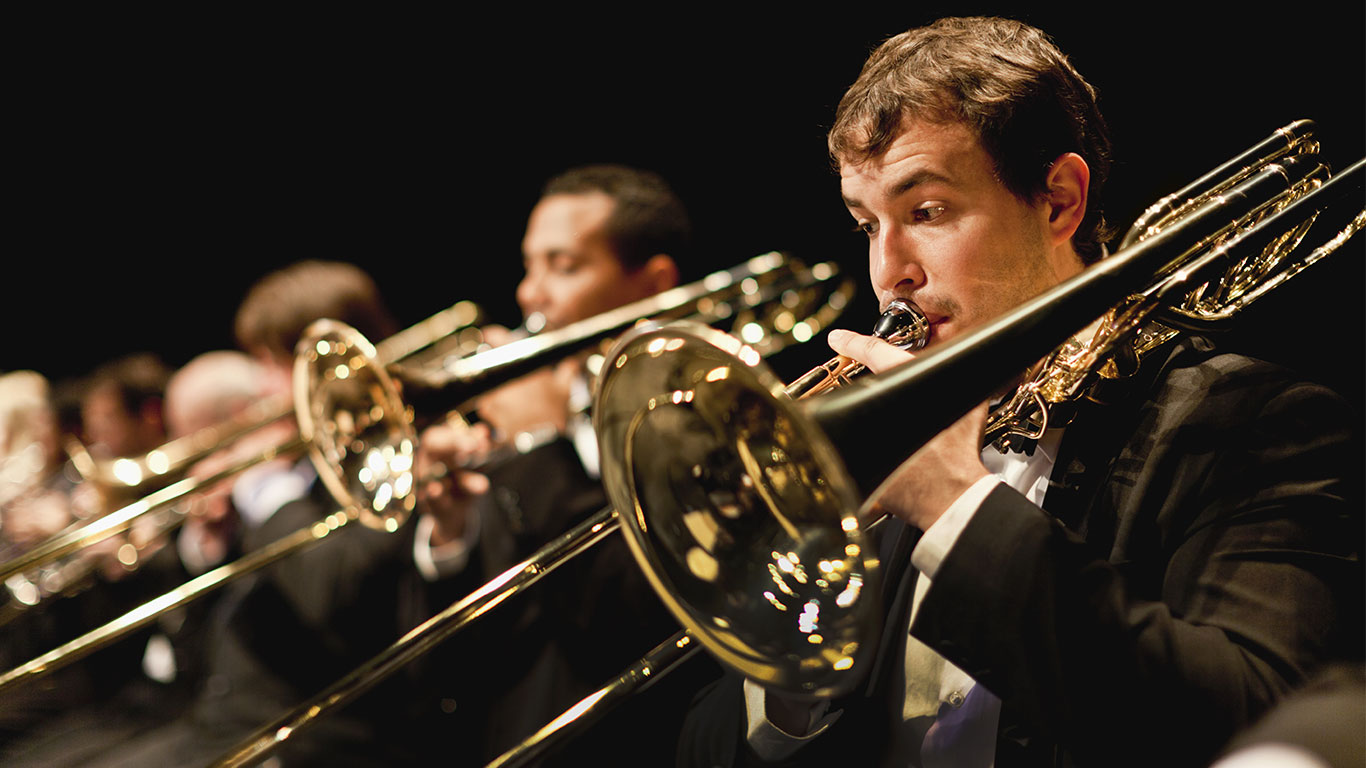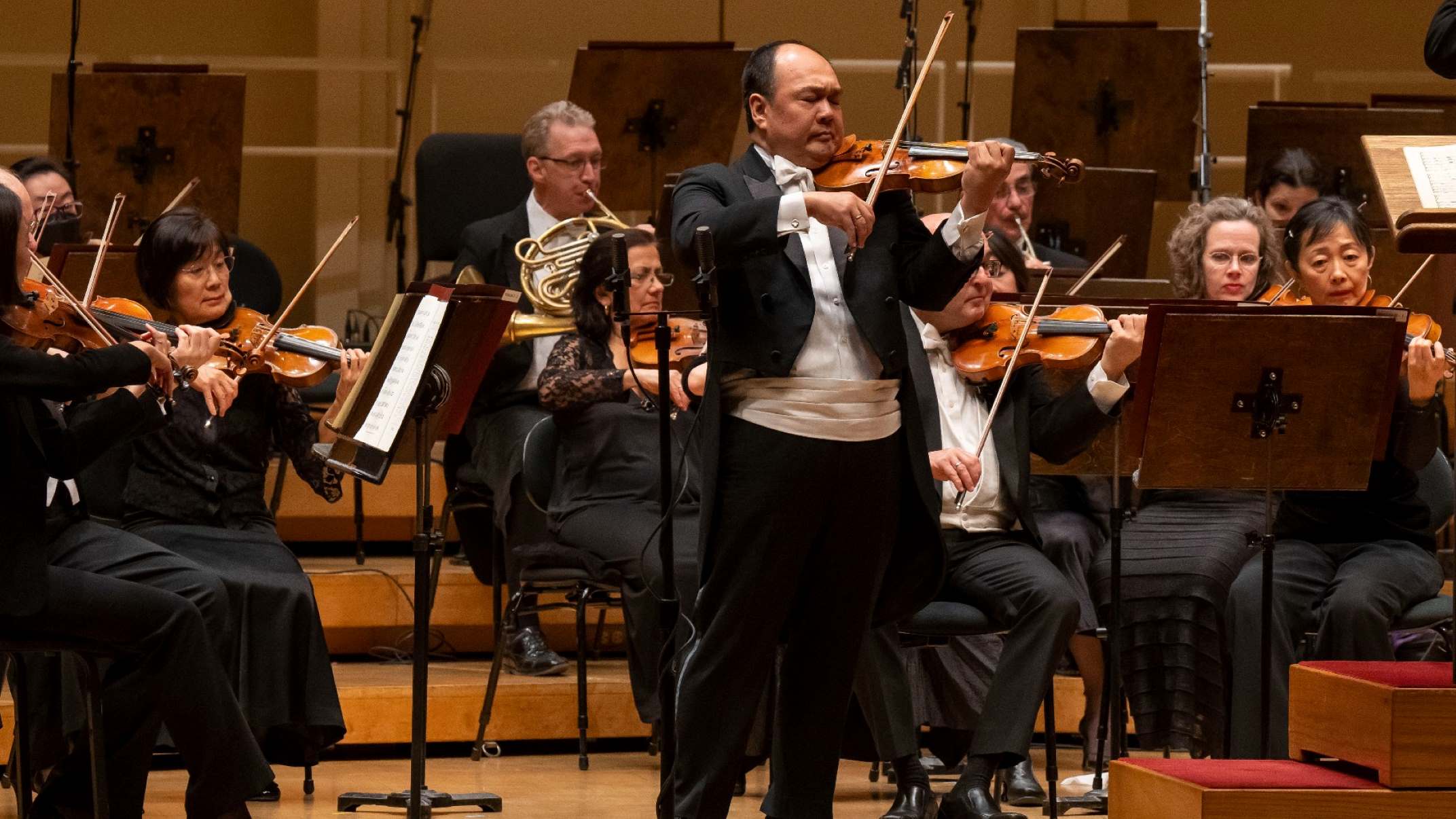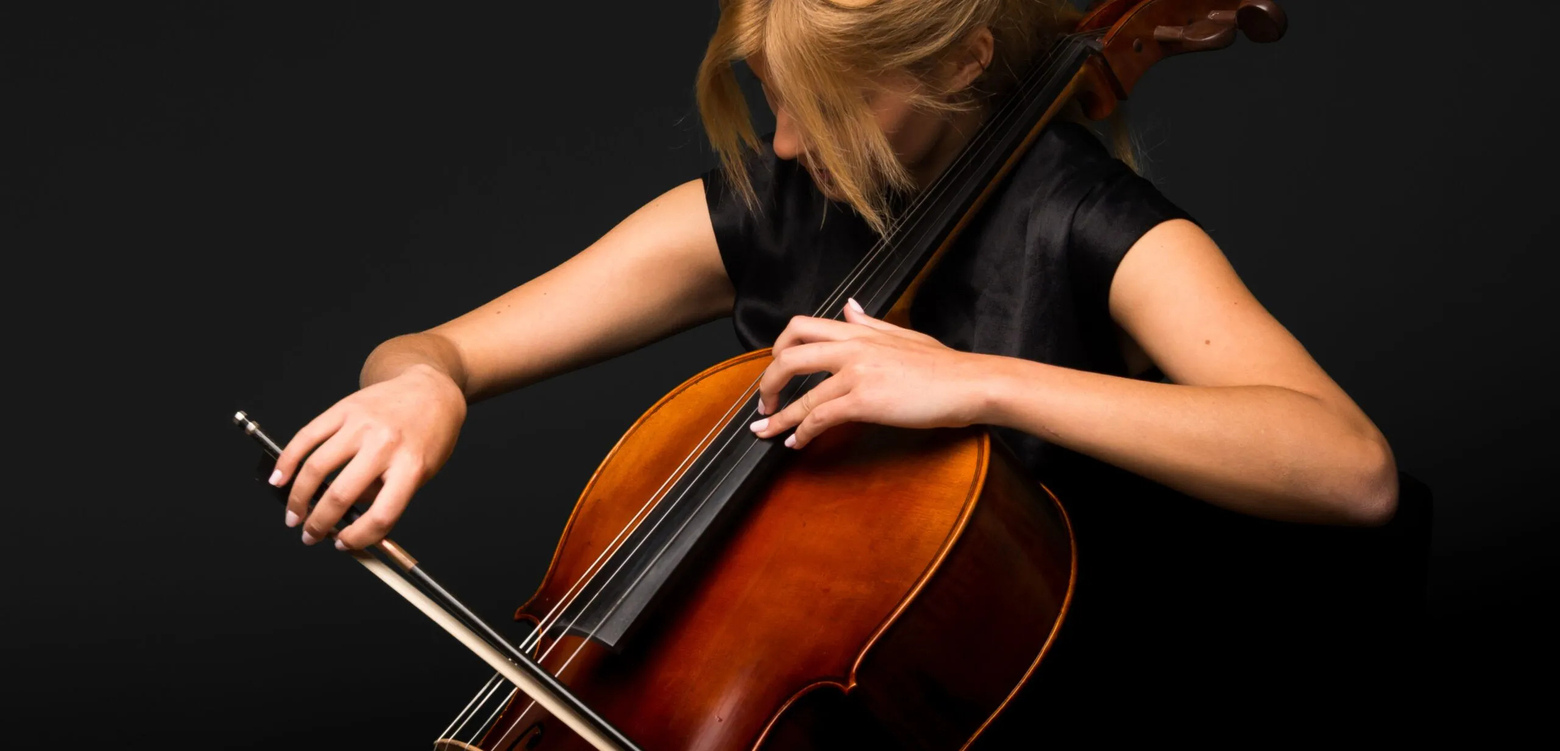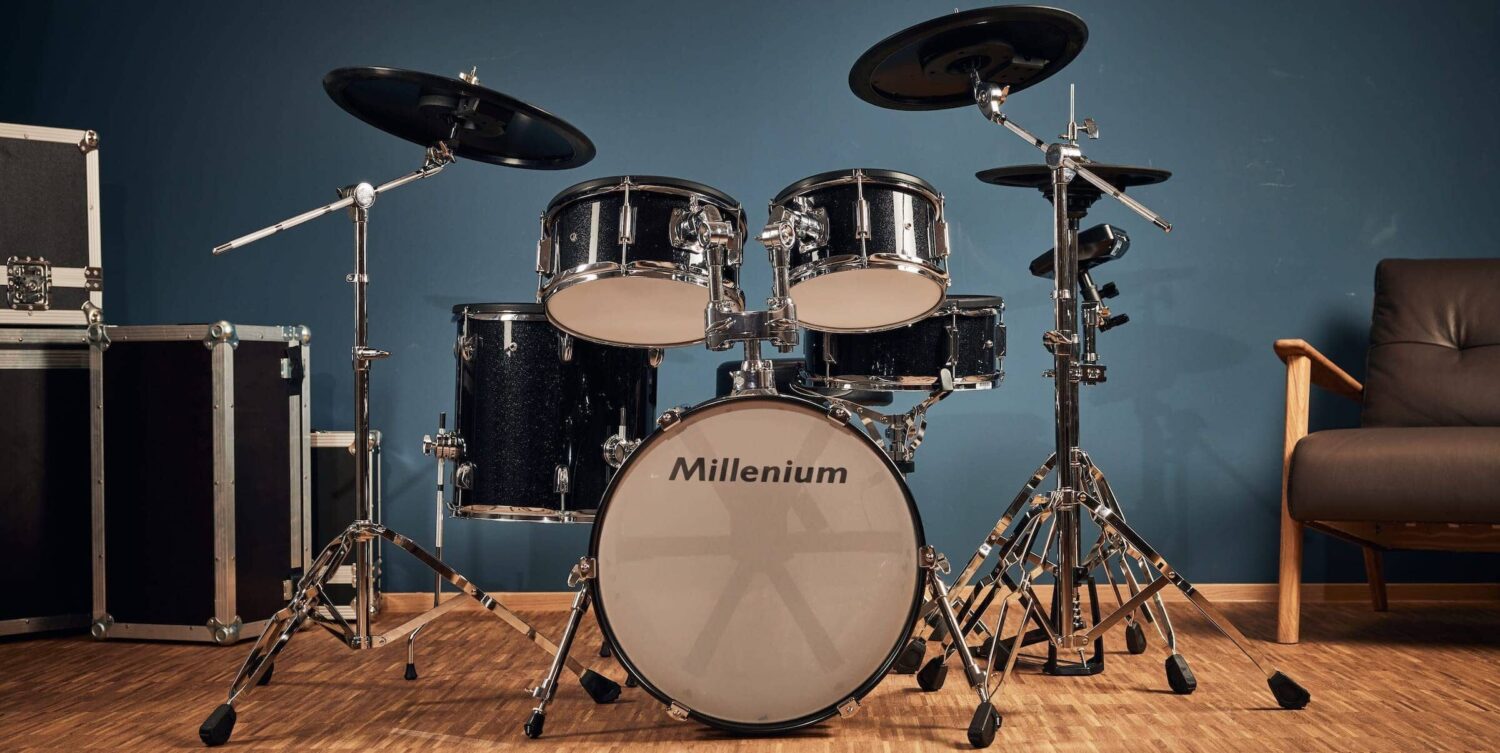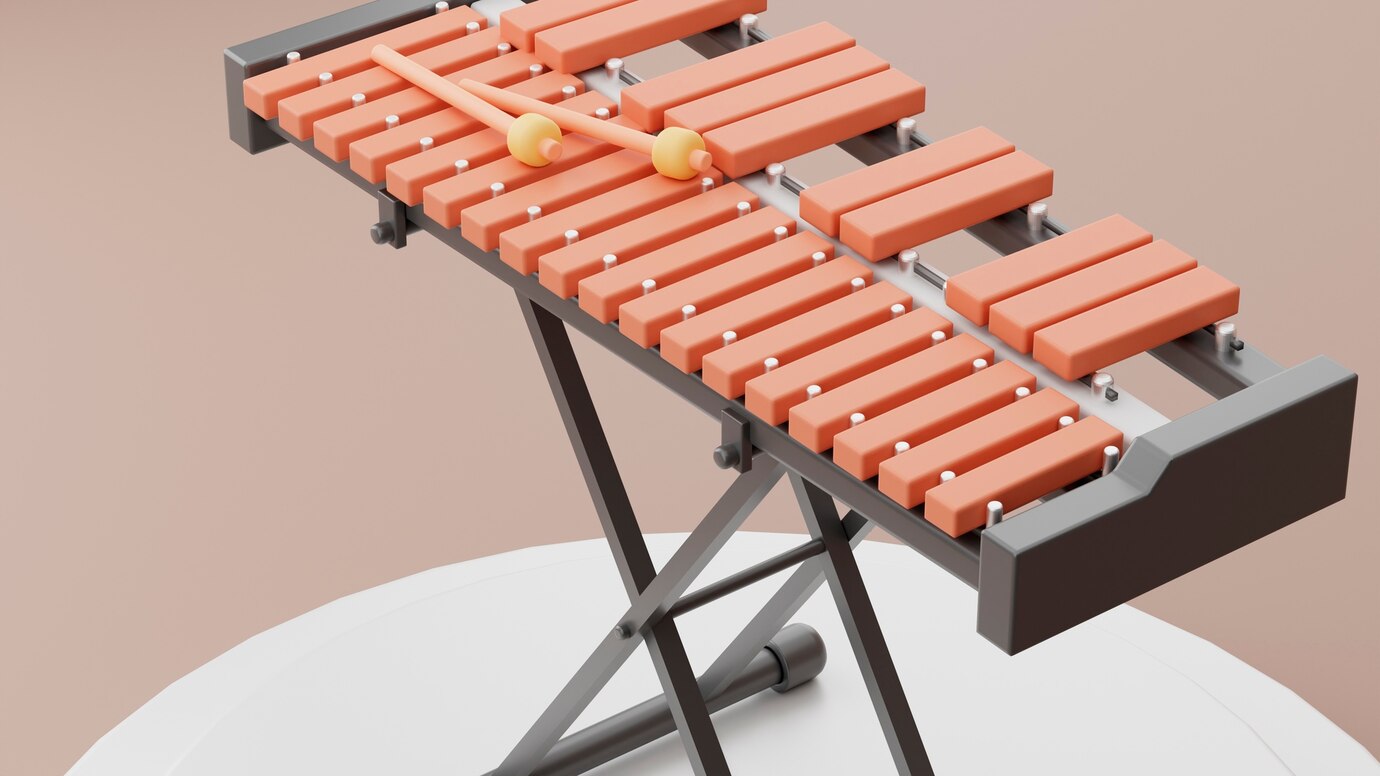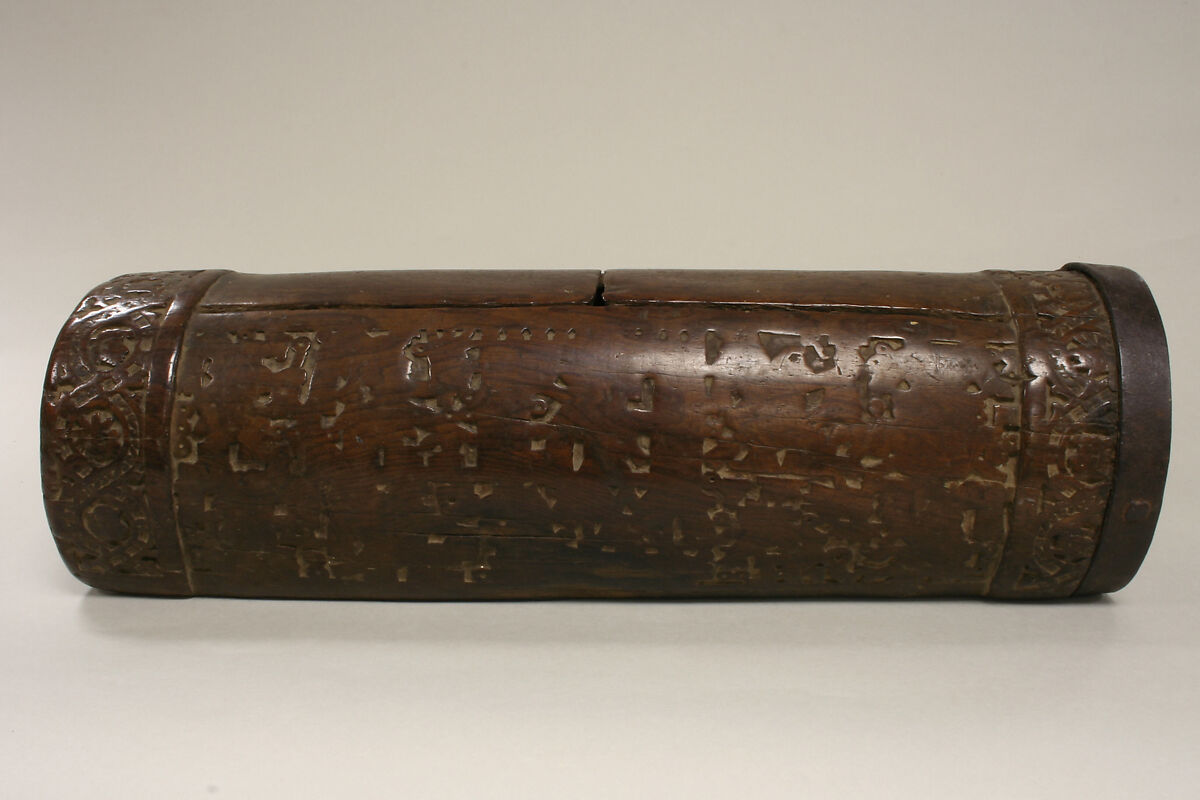Home>Instruments>Percussion Instruments>Which Percussion Instruments Would You Usually Find In A Symphony Orchestra


Percussion Instruments
Which Percussion Instruments Would You Usually Find In A Symphony Orchestra
Modified: January 22, 2024
Discover the essential percussion instruments commonly found in a symphony orchestra. Uncover the diverse sounds and rhythms created by these instruments.
(Many of the links in this article redirect to a specific reviewed product. Your purchase of these products through affiliate links helps to generate commission for AudioLover.com, at no extra cost. Learn more)
Table of Contents
Introduction
When you think of a symphony orchestra, you might picture a grand stage filled with stringed instruments, wind instruments, and maybe even a grand piano. But there is one vital component that adds depth, rhythm, and excitement to the symphonic sound – percussion instruments.
Percussion instruments play a crucial role in the symphony orchestra by providing a wide range of unique sounds and textures that can enhance the overall musical experience. From driving rhythms to delicate melodies, these instruments add a layer of complexity and emotion to the music.
In this article, we will delve into the world of percussion instruments commonly found in a symphony orchestra. We will explore their characteristics, roles, and the distinct sounds they contribute to the ensemble. Whether you are a music enthusiast or a curious learner, this article will help you develop a greater appreciation for the percussion section in a symphony orchestra.
Join us as we explore the diverse range of percussion instruments that make up the symphony orchestra, from the thunderous timpani to the shimmering cymbals, and everything in between.
Percussion Instruments in a Symphony Orchestra
In a symphony orchestra, the percussion section is responsible for providing a rhythmic foundation, adding dramatic impact, and creating various sound effects. A wide variety of percussion instruments are utilized, each with its own unique characteristics and playing techniques.
These instruments are divided into two main categories: pitched percussion and unpitched percussion. Pitched percussion instruments produce definite pitches and are tuned to specific notes, similar to melodic instruments. Unpitched percussion instruments, on the other hand, do not produce definite pitches and are utilized for their rhythmic and textural qualities.
The inclusion and placement of percussion instruments in a symphony orchestra vary depending on the musical composition and the preferences of the composer. Some pieces may only require a small selection of instruments, while others may call for a robust and diverse percussion section.
Now, let’s dive into the fascinating world of percussion instruments found in a symphony orchestra, and discover the role they play in creating captivating and dynamic musical performances.
The Timpani
The timpani, also known as kettle drums, is one of the most recognizable percussion instruments in a symphony orchestra. These large, bowl-shaped drums are played using mallets, and their pitch can be adjusted by tightening or loosening the tension rods located around the drum head.
The timpani are capable of producing a wide range of pitches, making them one of the few pitched percussion instruments in the orchestra. Typically, there are two to four timpani drums of different sizes and pitches, allowing the percussionist to create melodic patterns and powerful accents that complement the overall music.
The timpani is often responsible for providing a solid rhythmic foundation, establishing the tempo, and marking important transitions in the music. Its deep, resonant tone adds depth and gravitas to the orchestra’s sound, making it particularly effective in majestic and dramatic musical passages.
In addition to their rhythmic role, timpani can also be used for expressive melodic phrases, adding a lyrical quality to the music. Skilled timpanists can create melodic motifs that intertwine with the melodies played by other instruments, enhancing the overall musical texture.
Playing the timpani requires a combination of precision, musicality, and physical strength. The percussionist must have a keen sense of timing and be able to execute dynamic changes effectively. They must also have a good understanding of musical interpretation, as they often need to coordinate with other sections of the orchestra to create a unified and cohesive performance.
The timpani’s majestic presence and versatile sound make it an essential component of the percussion section in a symphony orchestra. Its ability to balance rhythm and melody adds depth and richness to the overall symphonic sound, making it a favorite among composers and audiences alike.
The Snare Drum
The snare drum is a staple percussion instrument in a symphony orchestra. Its distinct sound and versatile playing techniques make it an integral part of the percussion section. The snare drum consists of a cylindrical shell made of wood or metal, with a drumhead stretched tightly across one or both ends.
One of the defining features of the snare drum is its snare wires, which are positioned against the bottom drumhead. These wires create a rattling sound when the top drumhead is struck, giving the snare drum its characteristic snappy and vibrant tone. The snare drum can be played with drumsticks, brushes, or even hands, allowing for a wide range of dynamic and tonal possibilities.
In a symphony orchestra, the snare drum serves multiple purposes. It provides a crisp and precise rhythmic foundation, helping to keep the ensemble in sync. It is often used to accentuate certain beats or emphasize specific musical phrases, adding drama and excitement to the music.
Aside from its rhythmic role, the snare drum can also create various sound effects. The use of different playing techniques, such as rimshots, rolls, and buzzes, allows the percussionist to produce a range of distinctive sounds. These effects can be employed to depict specific musical scenes or create atmospheric textures in the music.
Playing the snare drum in a symphony orchestra requires not only technical proficiency but also a keen ear for dynamics and a sense of musicality. The percussionist must carefully balance the volume and intensity of their playing to blend with the other instruments and enhance the overall sound of the orchestra.
The snare drum’s versatility and ability to add both rhythm and texture make it an indispensable component of the percussion section in a symphony orchestra. Its crisp and lively sound, along with its wide range of expressive possibilities, ensures that it remains a favorite among composers, conductors, and audiences alike.
The Bass Drum
The bass drum is a powerful and impactful percussion instrument that plays a significant role in a symphony orchestra. Also known as the kick drum, it is the largest drum in the orchestra’s percussion section, typically made of a wooden or metal shell with a drumhead stretched across one side.
The bass drum’s primary function is to provide a deep and resonant low-pitched sound, often characterized by its booming and reverberating quality. This instrument adds weight and intensity to the orchestra’s sound, creating a strong foundation for the ensemble.
In a symphony orchestra, the bass drum is commonly used to emphasize climactic moments or mark significant transitions in the music. Its thunderous sound can create a sense of anticipation or add dramatic impact to a composition. When played with precision and control, the bass drum can evoke a range of emotions, from power and excitement to darkness and foreboding.
The bass drum is played with a variety of mallets or beaters, depending on the desired tone and effect. Different techniques, such as striking the drumhead in the center or near the edge, can also produce varying sounds and dynamics.
Besides its rhythmic role, the bass drum can also be used to create special effects and unique textures within the music. By using techniques like dragging a pedal along the drumhead or placing various objects on the drumhead, percussionists can produce unconventional sounds, enhancing the overall sonic palette of the orchestra.
Playing the bass drum requires not only physical strength but also a keen sense of timing and control. The percussionist must be able to precisely execute accents and entrances, ensuring that the bass drum enhances the overall musicality of the composition.
With its commanding presence and deep resonance, the bass drum adds depth and gravitas to a symphony orchestra. Its ability to provide a solid rhythmic foundation and create impactful moments makes it an essential instrument in the percussion section, contributing to the overall power and richness of the orchestral sound.
The Cymbals
When it comes to adding shimmer and brilliance to a symphony orchestra, the cymbals take center stage. These metal percussion instruments consist of two circular plates made of brass or bronze alloy, known as the cymbals, which are played together or individually to produce a bright and resonant sound.
The cymbals are known for their versatility and ability to produce a wide range of expressive sounds. When struck with soft mallets or brushes, they create a delicate and sustained shimmering effect. On the other hand, striking them with harder beaters or clashing them together produces a powerful and explosive crash.
In a symphony orchestra, the cymbals play a crucial role in punctuating climactic moments, adding dramatic accents, and creating dynamic contrasts within the music. Their bright and vibrant sound can uplift the energy of a composition and enhance its emotional impact.
Aside from crashes and accents, the cymbals can also be rolled or scraped using special techniques to create continuous shimmering effects or eerie textures. These techniques add depth and subtlety to the orchestra’s sound, providing an atmospheric quality to the music.
Playing the cymbals requires a high level of precision and control. The percussionist must carefully manage the timing and volume of their strikes to blend seamlessly with the rest of the orchestra. This delicate balance ensures that the cymbals enhance the overall musicality without overpowering other instruments.
While the cymbals may seem simple in design, their impact on the symphony orchestra is significant. Their ability to add brightness, excitement, and even ethereal qualities makes them an indispensable part of the percussion section. With a single crash or a gentle shimmer, the cymbals have the power to elevate the emotional depth of a musical performance and captivate audiences with their stunning presence.
The Tambourine
The tambourine is a percussion instrument that adds a joyful and rhythmic element to a symphony orchestra. It consists of a wooden or plastic circular frame with pairs of small metal jingles, known as zils, attached to it. This versatile instrument can be played in a variety of ways, creating a range of sounds and effects.
Traditionally, the tambourine is played by shaking it, striking it with the hand or fingers, or even flicking the zils with the thumb. Its distinctive jingling sound adds an element of brightness and sparkle to the orchestra’s overall texture.
In a symphony orchestra, the tambourine is often utilized to provide a rhythmic pulse, especially in music with a folk or dance-like character. Its crisp accents and shimmering tones can reinforce the beat and create a sense of momentum and drive.
Besides its rhythmic role, the tambourine can also be used to create special effects and add color to the music. By shaking it vigorously or using techniques like finger rolls or thumb flicks, the percussionist can produce swirling or trilling sounds that enhance the atmosphere of a composition.
Additionally, the tambourine can serve as a percussion instrument that enhances the visual aspect of a musical performance. Its vibrant and animated motions, coupled with its cheerful sound, can add an element of excitement and spectacle to the orchestra’s stage presence.
Playing the tambourine requires a combination of dexterity and musicality. The percussionist must have a good sense of rhythm and timing to maintain a steady pulse and execute precise accents. They must also be mindful of the tambourine’s dynamic range and use the appropriate technique to achieve desired sound effects.
With their jingling melodies and rhythmic energy, tambourines bring a sense of cheerfulness and liveliness to a symphony orchestra. Their playful nature and ability to contribute both rhythm and color make them an essential part of the percussion section, adding an extra layer of excitement and joy to the overall musical experience.
The Triangle
The triangle is a small but mighty percussion instrument that adds a delicate sparkle and shimmer to a symphony orchestra. It consists of a curved metal rod bent into the shape of a triangle, with one corner left open for hanging. When struck with a metal beater or rod, the triangle produces a clear and penetrating sound.
While the triangle may seem simple in its design, it plays a crucial role in the orchestra. It is often used to highlight specific beats or accents, providing a subtle and precise percussive element to the music. The triangle’s distinctive and pure tone cuts through the ensemble, making it easily discernible amidst the other instruments.
Playing the triangle requires skill and finesse. The percussionist must strike it precisely at the sweet spot, usually near the top corner, to achieve a clear and resonant sound. Additionally, they must have a sense of timing and control to execute accurate entrances and releases, ensuring that the triangle enhances the overall musical flow.
While the triangle is primarily used for its rhythmic function, it can also be utilized to create shimmering and ethereal effects. By lightly striking or scraping the triangle using different techniques or manipulating its suspension ring, the percussionist can produce delicate and atmospheric textures.
Moreover, the triangle is sometimes employed to add a touch of whimsy or playfulness to the music. Its distinctive sound can evoke images of fairy tales or magical moments, enhancing the storytelling aspects of a composition.
Despite its seemingly simple nature, the triangle’s ability to add a touch of brilliance and clarity to the symphony orchestra is unmatched. Its precise and shimmering sound can enrich the overall musical experience, providing a subtle yet essential element that elevates the performance to new heights.
The Glockenspiel
The glockenspiel is a captivating and enchanting percussion instrument that adds a touch of brilliance and melody to a symphony orchestra. It consists of a set of metal bars in varying lengths, arranged in a keyboard-like fashion. Each bar is tuned to a specific pitch, allowing the percussionist to play melodic passages.
Played with small mallets or beaters, the glockenspiel produces a bright and bell-like sound. Its crystalline tones blend well with other orchestral instruments and can cut through the ensemble, adding a distinct sparkle to the overall sonic landscape.
In a symphony orchestra, the glockenspiel often plays a supporting role by adding color, texture, and melodic accents to the music. It can be used to emphasize certain passages, highlight specific harmonies, or provide delicate countermelodies that interact with other instruments.
The glockenspiel’s versatile range makes it suitable for various musical genres and styles. Whether it is playing delicate lullabies, vibrant dances, or complex classical compositions, the instrument contributes a unique sonic character that enhances the emotional impact of the music.
Playing the glockenspiel requires precision and a keen sense of musicality. The percussionist must be able to navigate the keyboard and execute accurate pitches with the appropriate dynamics. Additionally, they must be in sync with the conductor and the rest of the ensemble to seamlessly integrate their melodic contributions.
The glockenspiel’s enchanting and ethereal sound makes it a favorite among composers, as it can add a sense of playfulness, nostalgia, or enchantment to a composition. Its ability to evoke emotions and create a sense of wonder makes it a delightful addition to a symphony orchestra’s percussion section.
The Xylophone
The xylophone is a vibrant and melodic percussion instrument that brings a unique sound to the symphony orchestra. It features a series of wooden bars of different lengths, each tuned to a specific pitch. The bars are arranged in the same manner as a piano keyboard, allowing the percussionist to play melodies and chords.
Played with mallets, the xylophone produces bright and resonant tones. Its distinct timbre stands out in the orchestra, providing a percussive counterpart to the melodic instruments. With its crisp and clear sound, the xylophone adds a layer of excitement and articulation to the overall ensemble.
In a symphony orchestra, the xylophone often takes on a prominent role, playing melodic passages and adding rhythmic accents. It can be used to create catchy and memorable themes, liven up faster sections of a composition, or contribute to intricate counterpoint with other instruments.
The xylophone’s versatility allows it to adapt to various musical genres and styles. From cheerful and playful melodies to delicate and intricate passages, this instrument adds a range of expressive possibilities to the orchestra’s repertoire.
Playing the xylophone requires both technical proficiency and musical sensitivity. The percussionist must have excellent hand-eye coordination to strike the correct bars with precise timing and accuracy. Additionally, they must carefully control the dynamics and articulation to bring out the desired musical expression.
The xylophone’s vibrant and melodic qualities make it a cherished instrument in the symphony orchestra. Its ability to play both supporting and solo roles adds depth and complexity to the overall musical arrangement. Whether it’s dancing through a lively orchestral passage or taking center stage with a captivating solo, the xylophone never fails to captivate and delight both performers and audiences.
The Marimba
The marimba is a beloved percussion instrument that brings warmth, richness, and a wide range of melodic possibilities to a symphony orchestra. Similar in construction to the xylophone, the marimba features wooden bars arranged in the same keyboard-like fashion. However, unlike the xylophone, the marimba has resonators beneath the bars that amplify and sustain the sound.
Played with soft mallets, the marimba produces a mellow and resonant tone. Its deep and expressive sound brings a sense of depth and emotional richness to the orchestra. With its ability to sustain notes and create subtle and nuanced dynamic changes, the marimba is a versatile instrument for both solo passages and accompaniment.
In a symphony orchestra, the marimba often takes on melodic or supporting roles. Its beautiful and lyrical sound allows it to play expressive melodies, add harmonic texture, or create countermelodies that intertwine with other instruments. Additionally, the marimba can be used to add rhythmic accents and unique timbre to the overall ensemble.
Playing the marimba requires a high level of technical skill and musicality. The percussionist must have a sense of phrasing and interpretation to bring out the subtleties of the music. With precise mallet control and a keen understanding of dynamics, they can create a captivating and expressive performance.
The marimba’s versatility and rich tonal qualities make it a favorite of many composers. Its ability to evoke a wide range of emotions, from peaceful and lyrical to vibrant and energetic, makes it a valuable addition to the symphony orchestra’s percussion section.
Whether it’s playing a delicate solo or blending harmoniously with the rest of the ensemble, the marimba brings a touch of beauty and melodic depth to the symphony orchestra. Its distinctive sound and expressive capabilities ensure that it remains a cherished instrument in the world of orchestral music.
The Vibraphone
The vibraphone is a fascinating and versatile percussion instrument that adds a unique and ethereal quality to a symphony orchestra. It is constructed with metal bars similar to the xylophone and marimba, but it has electric-driven resonators beneath the bars that create a distinct vibrato effect.
Played with soft mallets, the vibraphone produces a shimmering and mysterious sound. Its resonant and atmospheric tones give it a haunting quality, making it an instrument of choice for creating otherworldly or dreamlike musical passages.
In a symphony orchestra, the vibraphone plays a diverse range of roles. It can be used for melodic lines, adding a captivating and atmospheric layer to the music. The distinctive vibrato effect produced by the instrument brings a sense of depth and emotional expression to the composition.
Aside from its melodic contributions, the vibraphone can also be employed for its rhythmic capabilities. With its ability to sustain notes and create clear rhythmic patterns, it adds a percussive texture to the ensemble. The vibraphone’s warm and resonant sound blends seamlessly with other instruments, enhancing the overall orchestral sound.
Playing the vibraphone requires a careful balance of technique and musicality. The percussionist must manipulate the instrument’s pedal to control the speed and depth of the vibrato effect. Additionally, they must have precise mallet control and a keen sense of dynamics to bring out the full potential of the vibraphone’s expressive capabilities.
The vibraphone’s captivating and mysterious sound makes it a favorite of composers looking to create evocative and atmospheric music. Its ability to evoke a wide range of emotions, from serenity to intrigue, makes it a valuable addition to the symphony orchestra’s percussion section.
Whether it’s providing ethereal melodies or adding an enchanting layer of ambience, the vibraphone brings a sense of enchantment and mesmerization to the symphony orchestra. Its unique sound and expressive possibilities ensure that it remains a cherished and sought-after instrument in the world of orchestral music.
The Celesta
The celesta is a captivating and enchanting percussion instrument that adds a magical and otherworldly quality to a symphony orchestra. It is a keyboard instrument with metal plates struck by hammers, producing a sweet and celestial sound reminiscent of bells or music boxes.
Played with delicate and precise touch, the celesta creates a unique and ethereal tone. Its gentle and shimmering sound adds a touch of enchantment and wonder to the orchestra’s overall texture. With its distinct timbre, the celesta stands out amidst the other instruments, creating an atmosphere of mystery and beauty.
In a symphony orchestra, the celesta often takes on a melodic role, playing delicate and intricate passages. Its soft and resonant sound brings a sense of delicacy and subtlety to the music. Composers often utilize the celesta to evoke magical or fantastical elements, enhancing the storytelling aspects of a composition.
Playing the celesta requires a delicate touch and a keen sense of dynamics. The percussionist must be able to bring out the expressive qualities of the instrument, from gentle whispers to more pronounced and lyrical lines. With precise finger placement and control, they can create a captivating and enchanting performance.
The celesta’s unique sound and ability to evoke a sense of wonder make it a cherished instrument in the symphony orchestra. Its delicate and ethereal qualities stand out in both solo passages and accompaniment, adding a touch of elegance and magic to the overall musical experience.
Whether it’s adding a subtle touch of shimmering melody or invoking a sense of whimsy and enchantment, the celesta brings a sense of beauty and etherealness to the symphony orchestra. Its distinct sound and enchanting capabilities make it a valuable addition to the percussion section, captivating audiences with its otherworldly presence.
The Harp
The harp is a majestic and enchanting instrument that adds a heavenly and ethereal element to a symphony orchestra. Its beautiful, illuminated structure consists of a series of strings stretched over a tall and curved frame. The harpist plucks the strings with their fingertips or using harp-specific techniques, producing a resonant and soothing sound.
The harp’s ability to create rich harmonies, delicate melodies, and cascading arpeggios makes it a versatile instrument in the symphony orchestra. With its wide range and expressive capabilities, the harp can evoke a sense of beauty, serenity, and even celestial wonder.
In an orchestra, the harp often plays a dual role of providing both rhythmic and melodic support. Its arpeggios and sweeping glissandos add a sense of movement and texture to the music. It can also play melodic lines, providing gentle and poignant solos or blending harmoniously with other instruments.
Aside from its rhythmic and melodic contributions, the harp can create subtle and ethereal effects through techniques such as harmonics and pedal changes. These techniques add depth and color to the music, transporting listeners to realms beyond the earthly realm.
Playing the harp requires immense skill and dexterity. The harpist must have a refined touch and a keen sense of phrasing and dynamics. With their precise plucking technique and control of the pedals, they can harness the harp’s immense potential and create a mesmerizing performance.
The harp’s resonant and celestial tones make it a beloved instrument in the symphony orchestra. Its ability to evoke a sense of tranquility, beauty, and wonder ensures that it remains a cherished and prominent addition to the percussion section. Whether it’s adding a delicate sparkle to a symphonic score or taking center stage with its captivating solos, the harp brings a touch of magic and enchantment to every orchestral performance.
The Piano (Sometimes Included)
The piano, although not traditionally a member of the percussion section, is occasionally included in a symphony orchestra due to its versatility and unique timbre. With its extensive range and expressive capabilities, the piano brings a powerful and resonant element to the ensemble.
As a keyboard instrument, the piano allows the performer to produce both melodic and harmonic elements simultaneously. Its hammers strike the strings inside the instrument, creating a dynamic and rich sound. The piano’s ability to play soft, lyrical passages as well as powerful, virtuosic sections makes it a versatile addition to the orchestra.
In a symphony orchestra, the piano is often featured as a solo instrument in certain compositions. It can deliver emotive and captivating melodies or provide intricate accompaniment to other sections of the orchestra. The piano’s presence adds depth and complexity to the ensemble, enhancing the overall sonic experience.
Additionally, the piano’s percussive qualities can be utilized to create unique rhythmic effects. Its strings can be muted or struck to produce percussive sounds, adding a touch of color and texture to the orchestra’s overall sound palette.
Playing the piano in a symphony orchestra requires exceptional skill and musicality. The pianist must possess a deep understanding of the music’s intricate nuances, as well as the technical prowess to execute challenging passages with precision. Cooperation and communication with the conductor and other musicians are essential to achieving a cohesive and unified performance.
While the piano may not always be included in a symphony orchestra, its presence brings a remarkable depth and versatility to the ensemble when featured. Whether taking the spotlight as a soloist or lending its unique timbre to the orchestra’s sonic tapestry, the piano adds a compelling and breathtaking dimension to symphonic compositions.
Conclusion
The percussion instruments in a symphony orchestra play a vital role in shaping the overall sound and adding depth to the ensemble. From the thunderous timpani to the delicate chimes of the celesta, each instrument brings its own unique character and contribution to the orchestra.
The rhythmic foundation provided by instruments like the snare drum and bass drum drives the music forward with their commanding and impactful sounds. The cymbals and tambourine add sparkles and accents, while the triangle contributes delicate and precise rhythms. The pitched percussion instruments, such as the xylophone and marimba, offer melodious lines and rich harmonies.
Throughout the symphony orchestra, the percussion instruments create a wide range of textures and effects, from soft and subtle to bold and dramatic. They enhance the emotional impact of a composition, capturing the audience’s attention and inviting them into the world of the music.
Playing these instruments requires technical proficiency, musicality, and an understanding of how to blend and interact with other sections of the orchestra. The percussionists contribute their skills not only to provide rhythm and color but also to communicate and collaborate with their fellow musicians to create a cohesive and captivating musical performance.
As an audience member, developing an appreciation for the percussion instruments in a symphony orchestra allows us to delve deeper into the intricate layers and nuances of the music. These instruments bring life to compositions, adding flourishes, dynamics, and textures that elevate the performance to new heights.
Whether it is the thunderous rumble of the timpani or the delicate shimmer of the triangle, each percussion instrument brings its own unique voice and contributes to the symphony orchestra’s collective sound. Together, they create a vibrant and immersive musical experience that captures the hearts and imaginations of audiences around the world.
So, the next time you find yourself listening to a symphony orchestra, take a moment to appreciate the talents of the percussionists and the vast array of percussion instruments that add rhythm, texture, and magic to the symphonic tapestry.

